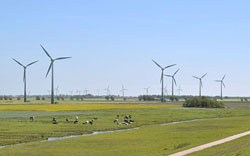
Private wind power 'needs the state'

The government, in its newly released Integrated Resource Plan (IRP) 2010-2030, plans for a reduced demand for wind energy, from 9,200MW to 4,360MW, just as it cuts projected national capacity requirements to 2030 by 6,600MW. It also moots a delay on a decision on a new nuclear building programme.
Comment on the document closes on February 7.
Siemens' Middle East and Africa sales head, Tom Pedersen, said the IRP allocation of 400MW-500MW a year was "simply not enough to create a sustainable, healthy and long-term manufacturing business in SA.... There are very few, if any, markets with a healthy wind industry and less than 1,000MW installed per year," he said, speaking ahead of April's Wind Energy Summit in Cape Town.
SA, according to the Organisation for Economic Co-operation and Development, is the fastest-growing renewable energy market in the Group of 20 major economies. The IRP envisages 17.8GW of renewable power by 2030, and is set to boost investment, but big investors mostly import technical equipment.
The 2008 global financial crisis curbed SA's manufacturing sector, which shed about 300,000 jobs. The sector is battling reduced external demand for products, competition from other manufacturing countries and tough economic conditions in its principal export markets - the US and European Union.
Investors need more incentives to invest in manufacturing plants
Wind farm developer Alan Wolfstrom said there was "not enough in the IRP" to persuade manufacturers to invest in plants in SA that would make turbines and blades, which were "the expensive part of the project". Greater demand would incite big players to develop factories.
Standard Bank renewable energy financing head Alistair Campbell said logistics and security concerns meant that careful planning was needed, and, because wind towers contained a lot of copper, there were "probably 300 or 400 turbines being held in storage at Coega, near Port Elizabeth - because it was a free-trade zone with security. Copper theft is rife in SA.
The proposed IRP adapts the IRP 2010-13, promulgated in March 2011, taking cognisance of SA's slowing economic growth. The earlier IRP projected demand of between 345 terawatt hours (TWh) and 416TWh by 2030, while the new IRP projects 454TWh.
While SA has been on tight energy supply since before the 2008 rolling blackouts that cost an estimated R50bn, the economy has slowed, along with much of the rest of the world. Eskom has begun a R300bn build programme, with 20,000MW of additional capacity due online by 2025. Wind farm developer Kilian Hagemann said SA's wind energy industry was entering a consolidation phase. Wind energy "definitely" had a long-term future in SA, but this depended on the government.
Wind is the way to go for cheap generation
Wind was the cheapest form of new electricity generation in SA, averaging R0.74/kWh in the independent power producer programme's third bid "window", he said. "As the first couple of projects are being built they are creating a very nice track record of showing that this can be done on time, within budget and with very positive socioeconomic spin-offs," Hagemann said.
This record contrasts with Eskom's build programme. The big Kusile and Medupi coal-fired power stations - each set to produce about 4,800MW - have been delayed by technical and labour trouble.
However, Hagemann said he believed prices would not keep falling, as the wind energy market had reached consolidation. Prices would stabilise instead.
Campbell said as the third round bid tariffs were "significantly lower than the cost of alternative energy such as coal", the need for tariff subsidies was "almost nonexistent and it could be argued that wind power is close to grid parity".
The IRP assumes a reduced demand for coal-fired power, from 6,250MW to 2,450MW.
Source: Business Day, via I-Net Bridge
Source: I-Net Bridge

For more than two decades, I-Net Bridge has been one of South Africa’s preferred electronic providers of innovative solutions, data of the highest calibre, reliable platforms and excellent supporting systems. Our products include workstations, web applications and data feeds packaged with in-depth news and powerful analytical tools empowering clients to make meaningful decisions.
We pride ourselves on our wide variety of in-house skills, encompassing multiple platforms and applications. These skills enable us to not only function as a first class facility, but also design, implement and support all our client needs at a level that confirms I-Net Bridge a leader in its field.
Go to: http://www.inet.co.za








